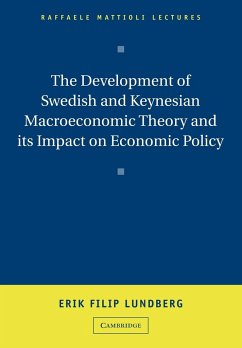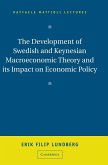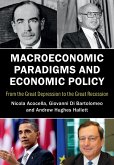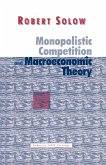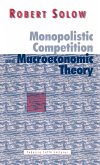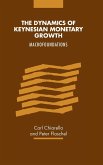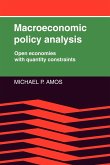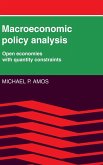Erik Filip Lundberg
The Development of Swedish and Keynesian Macroeconomic Theory and Its Impact on Economic Policy
Erik Filip Lundberg
The Development of Swedish and Keynesian Macroeconomic Theory and Its Impact on Economic Policy
- Broschiertes Buch
- Merkliste
- Auf die Merkliste
- Bewerten Bewerten
- Teilen
- Produkt teilen
- Produkterinnerung
- Produkterinnerung
This book explores the historical development of the Stockholm School of Economics in the wider Keynesian tradition.
Andere Kunden interessierten sich auch für
![The Development of Swedish and Keynesian Macroeconomic Theory and its Impact on Economic Policy The Development of Swedish and Keynesian Macroeconomic Theory and its Impact on Economic Policy]() Erik Filip LundbergThe Development of Swedish and Keynesian Macroeconomic Theory and its Impact on Economic Policy85,99 €
Erik Filip LundbergThe Development of Swedish and Keynesian Macroeconomic Theory and its Impact on Economic Policy85,99 €![Macroeconomic Paradigms and Economic Policy Macroeconomic Paradigms and Economic Policy]() Nicola AcocellaMacroeconomic Paradigms and Economic Policy49,99 €
Nicola AcocellaMacroeconomic Paradigms and Economic Policy49,99 €![Monopolistic Competition and Macroeconomic Theory Monopolistic Competition and Macroeconomic Theory]() Robert M. SolowMonopolistic Competition and Macroeconomic Theory38,99 €
Robert M. SolowMonopolistic Competition and Macroeconomic Theory38,99 €![Monopolistic Competition and Macroeconomic Theory Monopolistic Competition and Macroeconomic Theory]() Robert M. SolowMonopolistic Competition and Macroeconomic Theory66,99 €
Robert M. SolowMonopolistic Competition and Macroeconomic Theory66,99 €![The Dynamics of Keynesian Monetary Growth The Dynamics of Keynesian Monetary Growth]() Carl ChiarellaThe Dynamics of Keynesian Monetary Growth132,99 €
Carl ChiarellaThe Dynamics of Keynesian Monetary Growth132,99 €![Macroeconomic Policy Analysis Macroeconomic Policy Analysis]() Michael P. AmosMacroeconomic Policy Analysis32,99 €
Michael P. AmosMacroeconomic Policy Analysis32,99 €![Macroeconomic Policy Analysis Macroeconomic Policy Analysis]() Michael P. AmosMacroeconomic Policy Analysis77,99 €
Michael P. AmosMacroeconomic Policy Analysis77,99 €-
-
-
This book explores the historical development of the Stockholm School of Economics in the wider Keynesian tradition.
Produktdetails
- Produktdetails
- Verlag: Cambridge University Press
- Seitenzahl: 224
- Erscheinungstermin: 30. April 2010
- Englisch
- Abmessung: 244mm x 170mm x 12mm
- Gewicht: 395g
- ISBN-13: 9780521142632
- ISBN-10: 0521142636
- Artikelnr.: 29609799
- Herstellerkennzeichnung
- Libri GmbH
- Europaallee 1
- 36244 Bad Hersfeld
- gpsr@libri.de
- Verlag: Cambridge University Press
- Seitenzahl: 224
- Erscheinungstermin: 30. April 2010
- Englisch
- Abmessung: 244mm x 170mm x 12mm
- Gewicht: 395g
- ISBN-13: 9780521142632
- ISBN-10: 0521142636
- Artikelnr.: 29609799
- Herstellerkennzeichnung
- Libri GmbH
- Europaallee 1
- 36244 Bad Hersfeld
- gpsr@libri.de
Editorial foreword
First Lecture: The Theories of the Older Generation Economist. Policy Applications in the 1920s: 1. Introduction
2. The first Postwar crisis (1918-24)
3. The analysis of Swedish economists
4. The debate on economic policies
5. The suggested instruments of economic policy
Second Lecture: The Stockholm School and Keynes. The Experience of the 1930s: 6. The birth of the Stockholm school
7. The Swedish economy in the 1930s
8. General features of the Stockholm school approach to economic policy
9. The theories of the Stockholm school and their policy implications
10. The disequilibrium approach of the Stockholm school
11. Further differences between the approaches of Keynes and the Stockholm school
Third Lecture: Postwar Policy Issues and Policy Theories before the 1970s: 12. Evolution of the policy environment
13. Old traditions and innovations in policy analysis
14. Gunnar Myrdal's contribution and his opponents
15. Inflationary gap theories
16. The Rehn-Meidner model and the selective fiscal policy
Fourth Lecture: The Disequilibria of the 1970s and the Need for New Policy Theories: 17. The imbalance of the Swedish economy: 1974-81
18. The deficiency of policy models
19. New policy condition
20. The failure of Keynesian policies
21. Structural problems and supply-side economics
22. The debate about the size of the public sector
23. The need for demand and supply policies
24. Supply-side policies, efficiency and equity considerations
25. Concluding remarks on the role of economists
Discussion
Comments
Biography
Bibliography
Index.
First Lecture: The Theories of the Older Generation Economist. Policy Applications in the 1920s: 1. Introduction
2. The first Postwar crisis (1918-24)
3. The analysis of Swedish economists
4. The debate on economic policies
5. The suggested instruments of economic policy
Second Lecture: The Stockholm School and Keynes. The Experience of the 1930s: 6. The birth of the Stockholm school
7. The Swedish economy in the 1930s
8. General features of the Stockholm school approach to economic policy
9. The theories of the Stockholm school and their policy implications
10. The disequilibrium approach of the Stockholm school
11. Further differences between the approaches of Keynes and the Stockholm school
Third Lecture: Postwar Policy Issues and Policy Theories before the 1970s: 12. Evolution of the policy environment
13. Old traditions and innovations in policy analysis
14. Gunnar Myrdal's contribution and his opponents
15. Inflationary gap theories
16. The Rehn-Meidner model and the selective fiscal policy
Fourth Lecture: The Disequilibria of the 1970s and the Need for New Policy Theories: 17. The imbalance of the Swedish economy: 1974-81
18. The deficiency of policy models
19. New policy condition
20. The failure of Keynesian policies
21. Structural problems and supply-side economics
22. The debate about the size of the public sector
23. The need for demand and supply policies
24. Supply-side policies, efficiency and equity considerations
25. Concluding remarks on the role of economists
Discussion
Comments
Biography
Bibliography
Index.
Editorial foreword
First Lecture: The Theories of the Older Generation Economist. Policy Applications in the 1920s: 1. Introduction
2. The first Postwar crisis (1918-24)
3. The analysis of Swedish economists
4. The debate on economic policies
5. The suggested instruments of economic policy
Second Lecture: The Stockholm School and Keynes. The Experience of the 1930s: 6. The birth of the Stockholm school
7. The Swedish economy in the 1930s
8. General features of the Stockholm school approach to economic policy
9. The theories of the Stockholm school and their policy implications
10. The disequilibrium approach of the Stockholm school
11. Further differences between the approaches of Keynes and the Stockholm school
Third Lecture: Postwar Policy Issues and Policy Theories before the 1970s: 12. Evolution of the policy environment
13. Old traditions and innovations in policy analysis
14. Gunnar Myrdal's contribution and his opponents
15. Inflationary gap theories
16. The Rehn-Meidner model and the selective fiscal policy
Fourth Lecture: The Disequilibria of the 1970s and the Need for New Policy Theories: 17. The imbalance of the Swedish economy: 1974-81
18. The deficiency of policy models
19. New policy condition
20. The failure of Keynesian policies
21. Structural problems and supply-side economics
22. The debate about the size of the public sector
23. The need for demand and supply policies
24. Supply-side policies, efficiency and equity considerations
25. Concluding remarks on the role of economists
Discussion
Comments
Biography
Bibliography
Index.
First Lecture: The Theories of the Older Generation Economist. Policy Applications in the 1920s: 1. Introduction
2. The first Postwar crisis (1918-24)
3. The analysis of Swedish economists
4. The debate on economic policies
5. The suggested instruments of economic policy
Second Lecture: The Stockholm School and Keynes. The Experience of the 1930s: 6. The birth of the Stockholm school
7. The Swedish economy in the 1930s
8. General features of the Stockholm school approach to economic policy
9. The theories of the Stockholm school and their policy implications
10. The disequilibrium approach of the Stockholm school
11. Further differences between the approaches of Keynes and the Stockholm school
Third Lecture: Postwar Policy Issues and Policy Theories before the 1970s: 12. Evolution of the policy environment
13. Old traditions and innovations in policy analysis
14. Gunnar Myrdal's contribution and his opponents
15. Inflationary gap theories
16. The Rehn-Meidner model and the selective fiscal policy
Fourth Lecture: The Disequilibria of the 1970s and the Need for New Policy Theories: 17. The imbalance of the Swedish economy: 1974-81
18. The deficiency of policy models
19. New policy condition
20. The failure of Keynesian policies
21. Structural problems and supply-side economics
22. The debate about the size of the public sector
23. The need for demand and supply policies
24. Supply-side policies, efficiency and equity considerations
25. Concluding remarks on the role of economists
Discussion
Comments
Biography
Bibliography
Index.

